当前位置: Language Tips> 双语新闻
How did the ancient royal court celebrate Spring Festival?
快过年了,家家户户都忙着采办年货,辞旧迎新。老百姓在春节期间都会穿新衣、吃饺子、挂春联、走亲戚,这些都是从古代延续至今的传统。那么,你可知道古代的皇帝、娘娘们是怎么庆祝春节的吗?皇帝过年是不是也吃饺子呢?
|
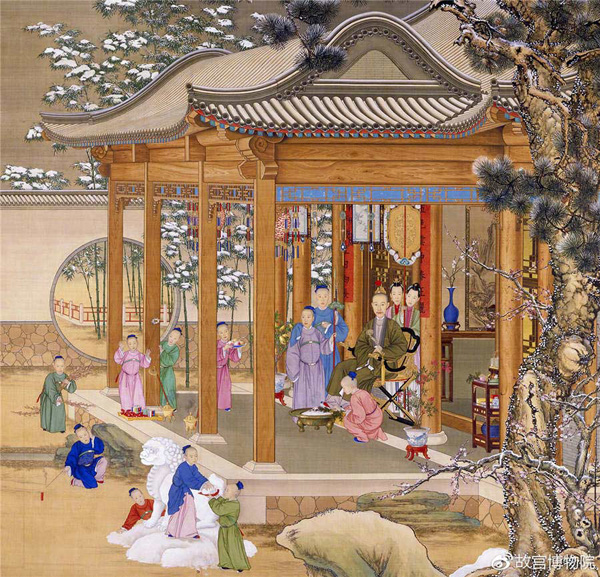 The painting portrays the Emperor Qianlong in the Qing Dynasty enjoying snow in the royal palace during the Spring Festival. [Photo/Official Weibo account of the Palace Museum] |
特别的服饰和餐食
Like common people, the ancient emperors would wear special clothes and arrange a special dinner for the big occasion.
和普通人一样,古代帝王也会穿特别的衣服,并安排特别的年夜饭。
On the Chinese New Year's Eve, the final day of the 12th month in the Lunar Calendar, the emperor would solemnly wear a bright yellow dragon robe stitched with gold and colored thread, and embroidered with dragon patterns and 12 ornaments. The emperor would also wear a fur coat, a crown on the head and court beads on chest. The whole garment in bright colors symbolizes auspiciousness and a prosperous nation.
在除夕这天,皇帝会穿上庄严的亮黄色龙袍,上面用金线和彩线绣出龙的图案及其他12种装饰图案和花纹。皇帝还会穿一件毛皮大衣,头上戴皇冠,胸前挂朝珠。这套颜色鲜艳的服饰象征着国家繁荣昌盛。
|
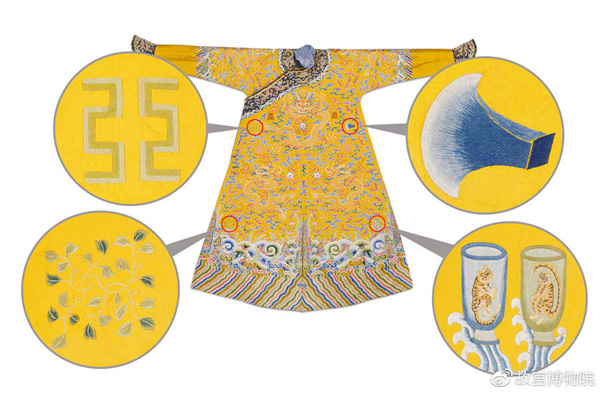 A dragon robe from the Qing Dynasty. [Photo/Official Weibo account of the Palace Museum] |
The first dinner in the Qing Dynasty (1644-1911) royal court was dumplings, just like common families. During the early Qing Dynasty, the emperor would eat dumplings with vegetable filling in Zhaoren Hall after the worship ceremony on New Year's Eve.
和普通人家一样,清代皇宫的年夜饭中也有饺子。在清代早期,皇帝在除夕的祭拜仪式过后,会在昭仁殿内吃素馅饺子。
Until the late Qing Dynasty, the Guangxu Emperor changed the dumpling eating location to the Hall of Mental Cultivation (Yangxin Dian) and the stuffing became various kinds of meat. The Empress Dowager Cixi would invite wives of royal families and princesses to the royal court to make dumplings together on New Year's Eve and sit together for a dumpling feast on the early morning of the New Year's Day.
到了晚清时期,光绪皇帝就把吃饺子的地方挪到了养心殿,饺子馅也改为各种肉馅。慈禧太后会在除夕邀请王公贵族的福晋和格格们进宫一起包饺子,并在大年初一一大早坐在一起吃饺子。
In addition, family feasts were also indispensable. The emperor would host family feasts with the queen, concubines and princes respectively. The feasts were held strictly in accordance with etiquette, such as the number of dishes, the color and quality of the tableware as well as the order of seats. Though called a family feast, the form and etiquette are more important than appetite.
此外,家庭聚餐也是必不可少的。皇帝会分别和皇后、妃嫔和阿哥们聚餐。家庭聚餐会严格遵守礼节,包括碗碟数量、餐具的颜色和质地以及入座顺序等都有规定。尽管被称作家庭聚餐,但是进餐的形式和礼节比食欲更为重要。
|
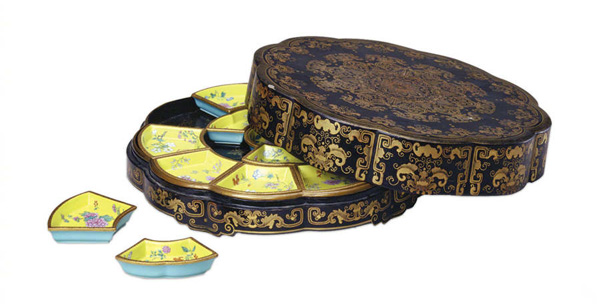 A delicate flower-patterned plate set from the Qianlong period of the Qing Dynasty. [Photo/Official Weibo account of the Palace Museum] |
The royal court also obeyed the traditional custom of staying up all night on New Year's Eve, so a midnight snack would be prepared for the emperor, which always included fresh and dried fruit displayed in auspicious patterns.
宫廷也要遵守除夕守岁的传统习俗,所以还会为皇帝准备夜宵,夜宵里少不了摆成吉利样式的新鲜水果和干果。
春节期间的娱乐活动
At the end of the New Year's Eve, also the start of the Chinese New Year, the emperor would wear formal dress and walk to the Dongnuan Pavilion in the Yangxin Dian, lighting a jade candle, pouring wine into the Cup of Solid Gold and then write auspicious words for the new year such as "Peace reigns over the country" or "Propitious weather for the crops". Then the emperor would drink Tusu wine, specially made for the Spring Festival, meant to get rid of plague and strengthen the body for the new year.
到了除夕的尾声,也就是农历新年的开端,皇帝会穿上正式的服装,走到养心殿的东暖阁点亮一枝玉烛,往纯金的杯子中倒酒,为新年写一些吉利的字词,比如“天下太平”,或者“风调雨顺”。接下来皇帝会饮用为春节特制的屠苏酒,寓意是祛除瘟疫,强健身体。
|
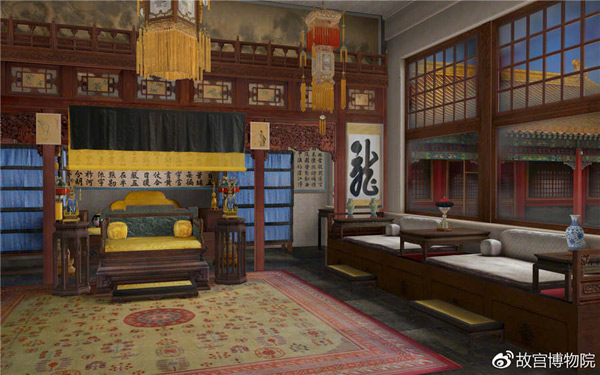 The Dongnuan Pavilion in the Yangxin Dian of the Forbidden City. [Photo/Official Weibo account of the Palace Museum] |
|
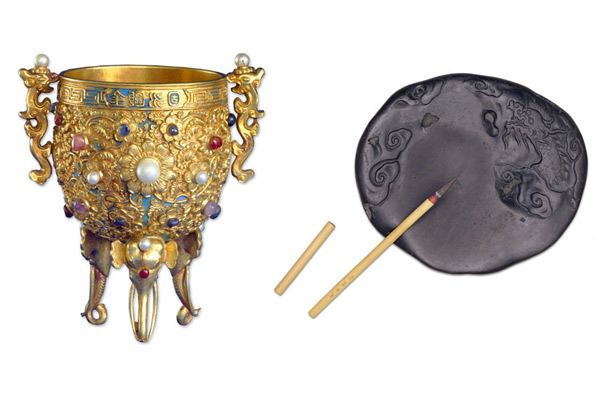 The Cup of Solid Gold from the Qing Dynasty (L); A writing brush used by ancient emperors from the Qing Dynasty. [Photo/Official Weibo account of the Palace Museum] |
From the second day of the first lunar month to the 10th day, an auspicious day would be chosen to hold a tea party, in which the emperor would invite dukes and ministers to create poetry under his rule and well-performed officials would be rewarded.
正月初二到初十期间,会选择一个吉利的日子来举行茶会,皇帝会邀请诸侯百官,定下规则请大家作诗,表现出色的官员将获得嘉奖。
During the ancient times when there was no television, a major recreation in the royal court was watching Chinese operas, which had to be lively and auspicious. Several emperors in the Qing Dynasty would act in operas themselves, such as the Qianlong Emperor, Daoguang Emperor and Tongzhi Emperor. The Guangxu Emperor could even beat drums.
古代没有电视,皇宫里主要的娱乐活动就是看戏,剧目要热闹喜庆。清代的几位皇帝还会亲自参演,比如乾隆皇帝、道光皇帝和同治皇帝。光绪皇帝甚至还会打鼓。
|
 A helmet (L) and a garment used in opera performance from the Qing Dynasty.[Photo/Official Weibo account of the Palace Museum] |
挂春联,贴门神
Hanging spring couplets and pasting door gods is a major custom during the Spring Festival. But in the Forbidden City, with its many palaces and doors, that would require a great deal of labor.
挂春联、贴门神是春节期间的重要传统。但在紫禁城有这么多的宫门,都贴上还真得费不少力气。
The spring couplets in the royal court were mainly written by members of the Imperial Academy who were scholars of calligraphy. However, as there were many taboos in writing spring couplets, they could not showcase their talents entirely.
皇宫中的春联主要由翰林院的书法大师写就。但是,因为写春联有诸多禁忌,他们不能完全施展出自己的才华。
|
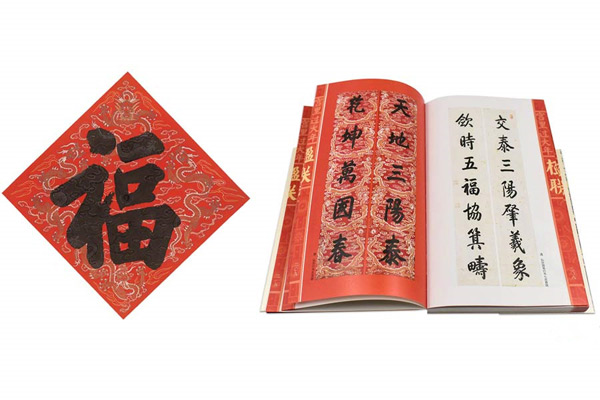 Regular script of the Chinese character fu (blessing) from the Qing Dynasty (L); Spring couplets from the Qing Dynasty. [Photo/Official Weibo account of the Palace Museum] |
The Ministry of Works and the Imperial Household Department were in charge of making the spring couplets and door gods in the royal palace, which would usually be expensive.
詹事府和内务府负责制作皇宫里的春联和门神,通常都花不少钱。
|
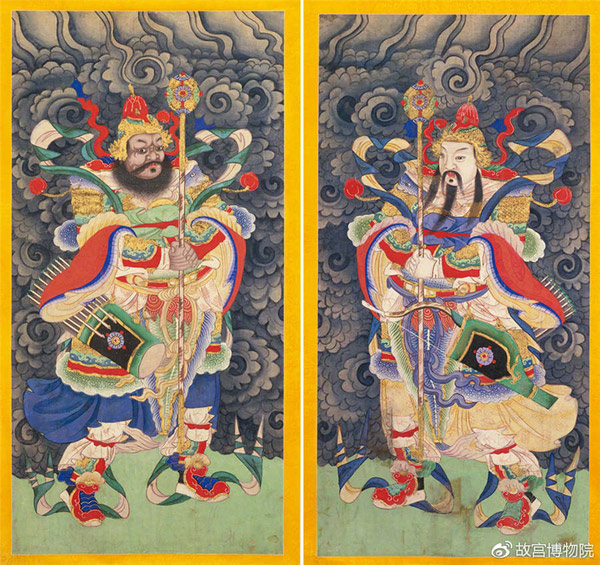 Door gods from the Qing Dynasty. [Photo/Official Weibo account of the Palace Museum] |
Unlike folk families, the spring couplets in the royal palace were written on white silk using ink, then framed and hung on the bright red pillars of the palaces. Thus the color contrast was enhanced to make the spring couplets more clear.
和民间不同,皇宫里的春联是用墨写在白绢上,然后装裱加框后挂在皇宫的红柱上。白色和红色的强烈对比让春联上的字更鲜明。
The couplets in the royal palaces were quite numerous and were mostly themed on eulogizing peaceful and flourishing eras, the emperor's merits and virtues, or blessings for a prosperous country and contented people.
皇宫里的春联很多,主题大多数是歌颂和平昌盛的年代,称赞皇帝的功德,或祈祷国泰民安。
No matter the superior emperor or common people, whether the ancient royal palace or modern families, the joyous mood and blessing for a better year during the Spring Festival has never changed.
无论是高高在上的皇帝还是普通老百姓,无论是在古代皇宫还是在现代家庭,春节期间的喜悦心情和对更美好的来年的祝福从来不曾改变过。
|
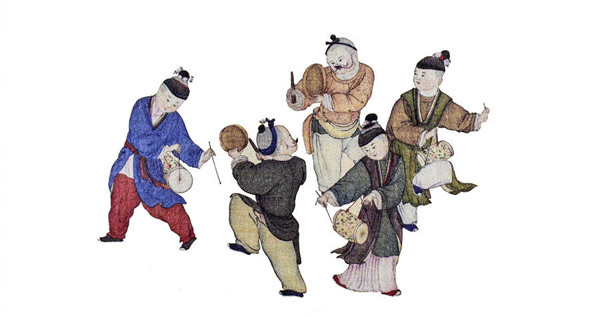 [Photo/Official Weibo account of the Palace Museum] |
英文来源:中国文化网
翻译&编辑:丹妮
上一篇 : 特鲁多“咬文嚼字”为哪般
下一篇 :
电话:8610-84883645
传真:8610-84883500
Email: languagetips@chinadaily.com.cn